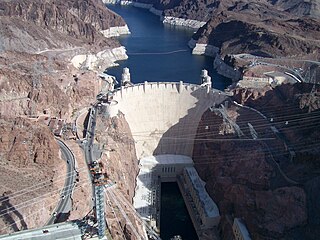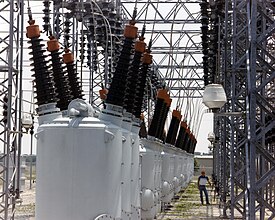
The Tennessee Valley Authority (TVA) is a federally owned electric utility corporation in the United States. TVA's service area covers all of Tennessee, portions of Alabama, Mississippi, and Kentucky, and small areas of Georgia, North Carolina, and Virginia. While owned by the federal government, TVA receives no taxpayer funding and operates similarly to a private for-profit company. It is headquartered in Knoxville, Tennessee, and is the sixth-largest power supplier and largest public utility in the country.

Samuel Taliaferro Rayburn was an American politician who served as the 43rd speaker of the United States House of Representatives. He was a three-time House speaker, former House majority leader, two-time House minority leader, and a 24-term congressman, representing Texas's 4th congressional district as a Democrat from 1913 to 1961. He holds the record for the longest tenure as Speaker of the United States House of Representatives, serving for over 17 years.

The Rural Electrification Act of 1936, enacted on May 20, 1936, provided federal loans for the installation of electrical distribution systems to serve isolated rural areas of the United States.
Oklahoma Gas & Electric Company is a regulated electric utility company that serves over 843,000 customers in Oklahoma and Arkansas, including 1.5 million people in the Oklahoma City Metropolitan Area. It is the leading subsidiary of OGE Energy Corp., with headquarters in downtown Oklahoma City. OGE Energy is also the former parent of Enogex Inc., a natural gas pipeline business which merged with CenterPoint Energy's midstream business to form Enable Midstream in 2013, in 2021 OGE and CenterPoint sold their general partnership in Enable Midstream to Energy Transfer. OGE Energy and its subsidiaries have about 3,100 employees.
The New York Power Authority (NYPA), officially the Power Authority of the State of New York, is a New York State public-benefit corporation. It is the largest state public power utility in the United States providing some of the lowest-cost electricity in the nation, operating 16 generating facilities and more than 1,400 circuit-miles of transmission lines. Its main administrative offices are in White Plains, New York

American Electric Power Company, Inc. (AEP), is a major investor-owned electric utility in the United States, delivering electricity to more than five million customers in 11 states.

As one of the four power marketing administrations within the U.S. Department of Energy, the Western Area Power Administration (WAPA)'s role is to market wholesale hydropower generated at 57 hydroelectric federal dams operated by the Bureau of Reclamation, United States Army Corps of Engineers and the International Boundary and Water Commission. WAPA delivers this power through a more than 17,000-circuit-mile, high-voltage power transmission system to more than 700 preference power customers across the West. Those customers, in turn, provide retail electric service to more than 40 million consumers. WAPA is headquartered in the Denver, Colorado suburb of Lakewood, Colorado.

Southwest Power Pool (SPP) manages the electric grid and wholesale power market for the central United States. As a regional transmission organization, the nonprofit corporation is mandated by the Federal Energy Regulatory Commission to ensure reliable supplies of power, adequate transmission infrastructure and competitive wholesale electricity prices. Southwest Power Pool and its member companies coordinate the flow of electricity across approximately 60,000 miles of high-voltage transmission lines spanning 14 states. The company is headquartered in Little Rock, Arkansas.

Denison Dam, also known as Lake Texoma Dam, is a dam located on the Red River between Texas and Oklahoma that impounds Lake Texoma. The purpose of the dam is flood control, water supply, hydroelectric power production, river regulation, navigation and recreation. It was also designated by the American Society of Civil Engineers as a National Historic Civil Engineering Landmark in 1993.

Idaho Power Company (IPC) is a regulated electrical power utility. Its business involves the purchase, sale, generation, transmission and distribution of electricity in eastern Oregon and southern Idaho. It is a subsidiary of IDACORP, Inc. The company's 24,000-square-mile (62,000 km2) service area generally follows the area around the Snake River and its tributaries.

The Snohomish County Public Utility District is a public utility agency providing power to over 367,000 customers in Snohomish County and on Camano Island, Washington. It provides water service to about 23,000 customers in the northeast section of the Snohomish County.
There is a large array of stakeholders that provide services through electricity generation, transmission, distribution and marketing for industrial, commercial, public and residential customers in the United States. It also includes many public institutions that regulate the sector. In 1996, there were 3,195 electric utilities in the United States, of which fewer than 1,000 were engaged in power generation. This leaves a large number of mostly smaller utilities engaged only in power distribution. There were also 65 power marketers. Of all utilities, 2,020 were publicly owned, 932 were rural electric cooperatives, and 243 were investor-owned utilities. The electricity transmission network is controlled by Independent System Operators or Regional Transmission Organizations, which are not-for-profit organizations that are obliged to provide indiscriminate access to various suppliers to promote competition.

Hydroelectricity is, as of 2019, the second-largest renewable source of energy in both generation and nominal capacity in the United States. In 2021, hydroelectric power produced 31.5% of the total renewable electricity, and 6.3% of the total U.S. electricity.
The Grand River Dam Authority (GRDA) is an agency of the state of Oklahoma created to control, develop, and maintain the Grand River waterway. It was created by the Oklahoma state legislature in 1935, and is headquartered in Tulsa, Oklahoma. GRDA was designed to be self-funding from the sales of electricity and water. The state of Oklahoma was to provide no funding from taxes. The Authority was authorized to issue revenue bonds to fund large-scale capital investments.

B A Steinhagen Reservoir is located near the town of Jasper, Texas in the east Texas Piney Woods at 30.85 North Latitude and 94.19 West Longitude. The borders of Tyler County and Jasper County are defined by the bed of the Neches River, and therefore bisect the lake on a North/South line. The lake was created as part of a project that focused on creating lakes for recreation, power generation, and water conservation on the Neches River and the Angelina River. For many years, locals have referred to both the lake and dam as "Dam B".

The U.S. State of Oklahoma has high potential capacity for wind power in the western half of the state. In 2021, Oklahoma's installed wind generation capacity was almost 10,500 megawatts, supplying over 40% of the state's generated electricity and 85% of Oklahoma's total generating capacity from all renewable resources.
The United States state of Arkansas is a significant producer of natural gas and a minor producer of petroleum.
California produces more renewable energy than any other state in the United States except Texas. In 2018, California ranked first in the nation as a producer of electricity from solar, geothermal, and biomass resources and fourth in the nation in conventional hydroelectric power generation. As of 2017, over half of the electricity (52.7%) produced was from renewable sources.



















